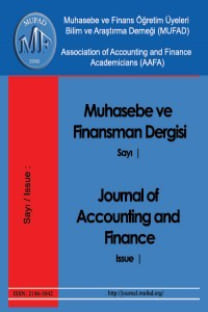TFRS 8 Faaliyet Bölümleri Standardı Çerçevesinde Coğrafi Bölümlere Göre Finansal Raporlama: İMKB-100 Sirketlerinde Uygulanma Düzeyi
Küresellesmenin bir sonucu olarak, bir taraftan çokuluslu isletme sayısı hızlı artarken, diğer taraftan bu isletmelerin faaliyette bulunduğu ülke sayısı da artmaktadır. Bu nedenle finansal raporlamada açık, ayrıntılı, yeterli düzeyde, karsılastırılabilir nitelikte ve zamanında bilgi sunma ihtiyacından dolayı bölümlere göre raporlama ve coğrafi bölümleme önemi de artmaktadır. Uluslararası Muhasebe Standartları Kurulu ile paralel biçimde, Türkiye Muhasebe Standartları kurulu tarafından yayımlanan TFRS 8 Faaliyet Bölümleri standardı bölümlere göre finansal raporlamada konusunda güncel bir çerçeve olusturmaktadır. Bu standart coğrafi bölümlere göre açıklama yapılmasının esaslarını da içermektedir. Bu çalısmamızda İMKB 100’de yer alan isletmelerin finansal tablolarında bölümsel raporlama uygulama düzeyleri ve özellikle de coğrafi bölümleme yapıp yapmadıkları, isletmelerin piyasa değerleri ve ödenmis sermaye seviyelerine göre ayrıntılı biçimde arastırılmıstır.
Anahtar Kelimeler:
Bölümsel raporlama, coğrafi bölümlere göre açıklamalar, TFRS 8 faaliyet bölümleri.
Financial Reporting as to Geographic Segmentation in terms of TFRS 8 Operating Segments: Level of Practice at ISE 100 Firms)
As a result of the process of globalization, the number of multinational enterprises has risen on the one hand and the number of the countries they have been in touch has enlarged on the other. Because of the need to provide, clear, detailed, adequate level, comparable and timely information, in financial reporting the importance of operating segments and geographic segment information continues to increase. TFRS 8 Operating Segments issued by Turkish Accounting Standards Board parallely International Accounting Standards Board, have a current(actual) frame about segment financial reporting. This standard also have principles of geographic segment disclosures. In this paper, we investigated that financial statements practises of operating segments and especially geographic segmentation in financial statements of ISE 100 firms, depending on those firms market values and size of paid-in capitals.
- ISSN: 2146-3042
- Yayın Aralığı: Yılda 4 Sayı
- Başlangıç: 2005
- Yayıncı: Muhasebe ve Finansman Öğretim Üyeleri Derneği (MUFAD)
Sayıdaki Diğer Makaleler
Demografik Faktörlerin Tüketici Kredisi Kullananların Temerrüde Düşmeleri Üzerindeki Etkisi
Mehmet Cihangir, İlkut Elif Kandil
Türkiye’de Muhasebe Meslek Örgütünün 20. Yılı - Bir Değerlendirme -
Sudi APAK, Kamer Agop Taşcıyan
Finansal Kriz Döneminde Türkiye’de Kredi Kartları
Başak Ataman, Evrim Altuk Özden
Muhasebe Departmanlarında Bilgi Yönetimi: Sakarya Örneği
Dilek Türk, Filiz Aygen, Şule Yıldız
Tam Zamanında Üretim Modeline Göre Maliyetlerin İzlenebilirliği
